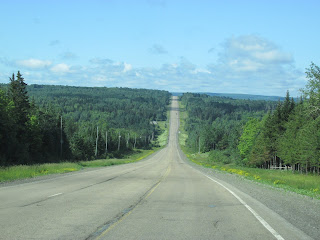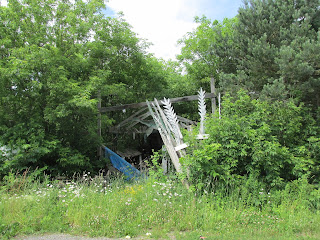We got up today, had a leisurely breakfast and left
Farmington ME. We enjoyed our visit with Phyllis & Wayne and thank them for
their hospitality!
Wilton, Maine is home to the annual Wilton
Blueberry Festival. It is always held the first Friday and Saturday of August.
It began in 1982 with a simple ‘Blueberry Church Bazaar.’ As the years have
passed, it has grown into a two-day signature event, and a time for people from
town and around to gather, socialize, and celebrate the heritage of this great
region. 35 years running and averaging more than 60 unique events throughout
the weekend, the festival has something new to offer year after year. We were
three weeks too early to enjoy it this year!
There certainly are many mountains in Maine. The
shadows they create are awesome, even on an overcast morning!
We entered the town of Dixfield Maine on Route 2. The town
motto of Dixfield is "The Only One" because it is the only town in
the world to claim that name. Where did a name like that come from? In 1795, the first six permanent settlers arrived with their
families Gould. It was called Holmantown Plantation until part of it was
incorporated on June 21, 1803 as Dixfield, the remainder of the plantation
would be incorporated in 1818 as Mexico. Dr. Elijah Dix of Boston, a
substantial landowner in the area, promised to donate a library for the town if
the citizens changed its name from Holmantown to Dixfield. The citizens
complied, after which the town received dusty old boxes of medical books printed
in German. Dr. Dix also left his name on Dixmont, where he died while visiting
in 1809 and was buried. With several streams for water power, Dixfield
developed into a small mill town. It had sawmills and gristmills. It also
produced cheese, carriages, shingles, toothpicks, rakes, wooden boxes, flies
and leaders, boots and shoes. Dixfield once had a marble works.
Next we came into the town of Mexico, known as the gateway
to Western Mountains. The Holmantown Plantation's remaining portion, which had
been first settled by Isaac Gleason, was incorporated on February 13, 1818 as
the town of Mexico. The name was inspired by local sympathy for Mexico's
1810–1821 fight for independence from Spain. Then known as Mexico Corner, it
developed as a farming community with mills at the streams. Mexico is located
on several hills overlooking the Androscoggin River. Across the river is the
town of Rumford, which has a large paper mill. The Swift River empties into the
Androscoggin at Mexico's southwest corner, its historic business center
positioned in the 19th-century near the source of water power. While the large
Androscoggin forms Mexico's southern boundary with Rumford, the smaller Swift
River more or less follows its western boundary with that town. Mexico's
downtown is located on land formed by the northeast corner of the right-angle junction
of the two rivers. These low lying riverbanks in Mexico have flooded many
times, including 1936, 1953 and 1987.
Speaking of the Town of Rumford, it was originally called
New Pennacook Plantation. The township was granted in 1779 to Timothy Walker,
Jr. and associates of Concord, New Hampshire. Both Pennacook and Rumford are
former names of Concord, from which many early settlers arrived. Incorporated
in 1800, the town would later annex land from Peru and Franklin Plantation. Located
in the foothills of the White Mountains, Rumford has a mighty fiberglass
woodsman (and Babe the Blue Ox) welcoming visitors. Rumford is also home of the
Tallest Falls east of the Niagara, which are, in fact, just up the street.
The Pennacook Falls, called by historian George J. Varney
"the grandest cataract in New England," where the Androscoggin River
drops 177 feet over solid granite. Bands of St. Francis Indians once hunted and
fished here, where salmon spawn in the 13-acre pool below Upper Falls, a
barrier that fish cannot pass. The river is home to a large population of the
finless brown variety of trout. Indians also came here to trade furs brought
from the lakes region. Sawmills and gristmills were built to harness water
power from the falls.
We passed Grafton Notch State Park. It has waterfalls, a
cave and a couple of big mountains. Old Speck Mountain topping out at 4,170
feet and Baldpate Mountain East Peak is 3,780 feet and West Peak at 3,662 feet.
A trip to this state park does not need to include a climb to the summit to experience
great views. There are great views of the notch from some notable spots that
don’t require much effort. And you can still hike part of the historic
Appalachian Trail. If you are not a hiker, but a waterfall lover, like me, the
highlight of the park is Screw Auger Falls.
In the community of Bethel, Maine you can see the imposing views
of Grafton Notch State Park, Bethel's tree-lined historic downtown village
common and the White Mountain National Forest. Bethel is situated on the banks
of the beautiful Androscoggin River and the Appalachian Mountains surrounds the
community. For over two hundred years, Bethel has been a favorite tourist
destination. We found this Norsmen Motel, which reminded us of our time in the
Canadian Maritimes.
In Gilend Maine, we found the Maine National Guard Bog Brook
Training Area. The Army Guard’s Bog Brook training area plays host to a pair of
week-long youth camps, where around 200 Maine youngsters, ages 5 to 18, come
together for camaraderie and campfires. It is also home to many training
exercises for the National Guard troops of western Maine and New Hampshire. We crossed from Maine into New Hampshire.
The first signs we saw after the welcome signs … were Moose
crossings …. This is a heavily wooded area, so I believe these signs! We were
traveling along the edge of the White Mountain National Forest.
The 800,000-acre White Mountain National Forest is a
powerful presence in the White Mountains. Adjacent to or part of every village
and town, the National Forest ensures that this region will remain largely
undeveloped. The WMNF is the only National Forest located in either New Hampshire
or Maine. Most of the major peaks over 4,000 feet high and there are over 100
miles of the Appalachian Trail traversing the White Mountain National Forest. The town of Gorham, New Hampshire is called the Great Woods
North Region. Woods and water dominate the landscape in the Great North Woods.
Sporting adventures are a way of life, from hunting to fishing, camping,
hiking, boating, wild life watching and snowmobiling.
Don’t you just love it when you’re driving along and you
look up and somebody has built something that makes you just go Hmmmm? Well we
found one of those things outside of Jefferson, New Hampshire. It is a stone
tower on the side of Route 2. Internet research tells me it is Carter’s Stone Tower.
James Richard Carter, a paper company mogul from the late 1800, built a vacation
estate in Jefferson. The 1800’s was when the rich started to build vacation
homes and venues like the Bretton Woods and Mt. Washington hotels for the
well-to-do to get away from the city during the hot summer’s. After finishing
the house and grounds he is reported to have built this rock tower which he may
have called “Carter’s Tower of Foolishness”. The building that is still
standing today has a series of inside stairs to the top of the tower where
panoramic view of the surrounding country can be seen. Apparently there may
have been a practical application for this tower. A railroad line was nearby
and since in those days trains were fired by coal sparks and fires were a
common occurrence along train lines. So the tower may have been for a fire watch
to protect the nearby estate, but it is all conjecture.
We turned onto Route 116, heading toward Littleton, New
Hampshire. It was called Chiswick (Saxon for "Cheese Farm") in 1764.
The town was part of Lisbon until 1770, when it was granted as Apthorp in honor
of George Apthorp, head of one of the wealthiest mercantile establishments in
Boston, Massachusetts. The land was later passed to the Apthorp family's
associates from Newburyport, Massachusetts, headed by Colonel Moses Little.
Colonel Little held the post of Surveyor of the King's Woods, and the town was
named in his honor when it was incorporated in 1784, the same year New
Hampshire became a state. Located along the banks of the Ammonoosuc River is
the Littleton Grist Mill. The historic mill first opened in 1798, and has been
fully restored to its original appearance. Between 1867 and 1909, the local
Kilburn Brothers factory published photographs, stereoviews, and sold
stereoscopes, double-picture viewers popular in the Victorian age.
Pollyanna of Littleton is the centerpiece of historic
downtown as an ambassador of cheer and community spirit for residents and
visitors alike. With her arms flung wide open, giving everyone a welcoming
wave! Littleton's jubilant bronze sculpture tributes hometown author, Eleanor
H. Porter, who is best remembered as the creator of the world's most optimistic
character, Pollyanna. Pollyanna Whittier is an orphan who goes to live with her
mean aunt in the dispirited New England town of Beldingsville, Vermont.
 |
| Community Piano, notice Pollyanna on the crosswalk! |
Influenced by her father’s unending optimism, she simply “plays the glad game”
whenever things get bleak—when she’s sentenced to eat bread and milk in the
kitchen with the servant, Nancy, for being late to dinner, she profusely thanks
her aunt because she loves milk and bread and Nancy. Porter’s book sold over a
million copies the first year, 1913, and by 1920 had already gone through 47
printings, a Broadway play, and the first of many films. Porter penned the
book’s sequel, Pollyanna Grows Up, in 1915, and several other writers have
written at least 13 more since.
 |
| The Pollyanna Gateway to the covered bridge & river |
Pollyanna’s influence reaches much further than New England.
Allan Moore’s comic The League of Extraordinary Gentlemen features a character,
Polly Whittier, who maintains an optimistic outlook despite attacks from the
Invisible Man. Merriam-Webster defines a “Pollyanna” as “a person characterized
by irrepressible optimism and a tendency to find good in everything,” and Ray
Bradbury once described himself to William Plummer (in a scrapped interview for
the Paris Review in 1976) as being “too much Pollyanna… But I don’t think I’m
too over optimistic.” Porter left Littleton for the New England Conservatory of
Music and never came back, but her forever optimistic character left an
impression on the people of the town, and they commemorated her gracious spirit
in bronze in 2002.
We visited Gail at the hotel she works at, Larry stopped in
to say hi too!
Ron and Patty opened their home and driveway for our overnight
stop. We had dinner at The Little Grill at the Depot and toured the town and
took a trip to Larry & Gail’s house.
It was great to see them all!


































































